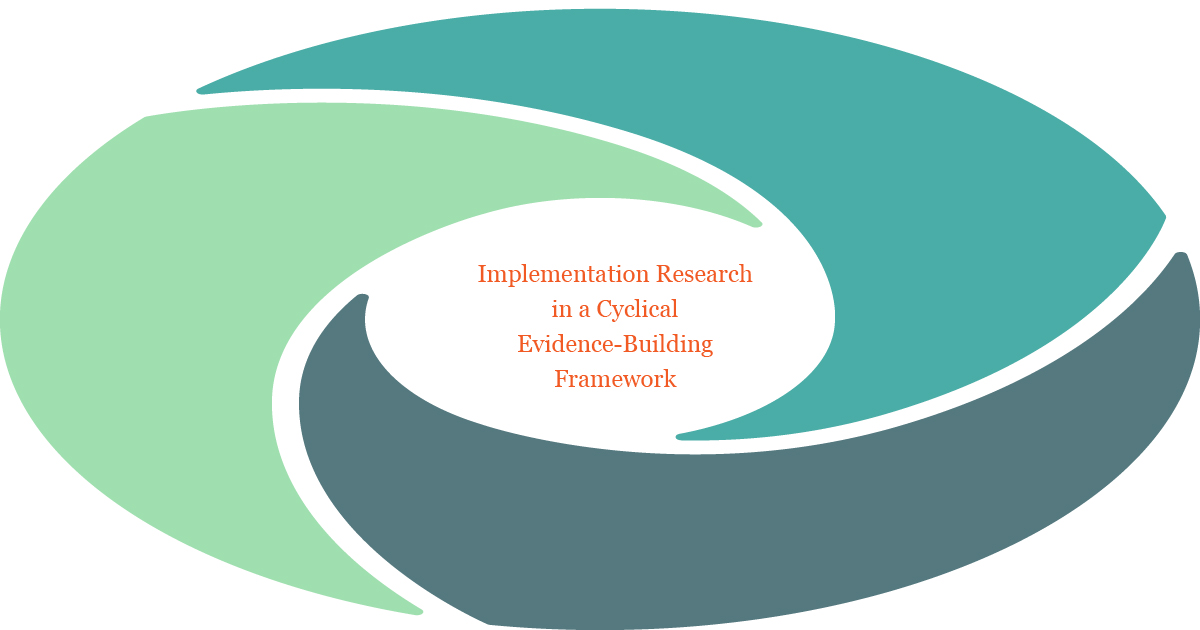Implementation Research in a Cyclical Evidence-Building Framework

How do we build evidence about effective policies and programs? The process is commonly depicted as a pipeline: from developing a new intervention to testing it on a small scale, to conducting impact studies in new locations, to expanding effective interventions. But an updated depiction of evidence building could better reflect realities of decision making and practice in the field. In a recent paper, we describe a cyclical framework that encompasses implementation, adaptation, and continued evidence building. Implementation research takes on a central role in this updated model.
Implementation research in the pipeline model
Within the pipeline model depicted in the figure below, implementation research has long provided insights into the what, who, where, why, and how of interventions and programs by analyzing details in a number of areas:
- Policy, political, economic, and social contexts in which interventions take place
-
Organizations and systems in which interventions are embedded
-
Differences between the services received by intervention and control group members, in the case of a randomized controlled trial (also known as service contrast)
-
Characteristics of staff members and participants, as well as their perceptions about and experiences in the program
-
Factors that may influence effectiveness in different contexts
An updated framework
The next figure shows an updated, cyclical framework that takes the research process further:
-
Building impact evidence about new approaches to social programs
-
Implementing evidence-based programs and supporting their expansion in ways that recognize the complexity inherent in replication
-
Encouraging adaptations and improvements
-
Assessing the need for further impact evidence

Through iteration, this process promotes innovation in a changing environment and continues to build credible evidence about whether and how programs bring down costs or have greater effects than the status quo. It has two key features that distinguish it from the pipeline framework:
-
It emphasizes the value of considering service contrast at every stage, not just in the evidence-building stage of impact studies.
-
The implementation of an evidence-based program is not the end point, as it is in the pipeline framework. Instead, the cyclical framework assumes the intervention will be adapted over time and across settings, so that impacts can be sustained or increased under changing circumstances. Innovation, learning, and building new evidence are part of the cycle.
Implementation research in the cyclical framework
The nature of implementation research is unlikely to change drastically in a cyclical evidence-building framework. It will continue to address core contextual and operational questions about new approaches to policy or programs. But because a cyclical framework explicitly includes phases of adaptation and incremental improvement, the importance of particular aspects of implementation research becomes even clearer:
-
Understanding the service contrast, in settings beyond an impact study
-
Documenting and communicating clearly about the environment in which a study is conducted: the context, systems, communities, organizations, program components, and populations involved
-
Articulating the program’s theory of change, and how it is used (or not) to guide implementation and adaptations
-
Detecting and tracking program adaptations by program decision makers and frontline staff members
-
Integrating implementation and impact research, with audiences of potential adopters and adapters in mind
Viewing program development as a cycle of evidence building, implementation, and adaptation provides a foundation for learning agendas that are attuned to the real-world needs of the people who will implement and adapt the programs. Implementation researchers have a key role to play as program operators systematically consider how, for whom, and where they operate programs, decide what adaptations they should make, and build new evidence about the effectiveness of those adaptations.






